Advertisements
Online Mock Tests
Chapters
![Frank solutions for Biology [English] Class 10 ICSE chapter 9 - Nervous System Frank solutions for Biology [English] Class 10 ICSE chapter 9 - Nervous System - Shaalaa.com](/images/9789386811653-biology-english-class-10-icse_6:b1353f382f20442081c2a5dff2d9de4a.jpg)
Advertisements
Solutions for Chapter 9: Nervous System
Below listed, you can find solutions for Chapter 9 of CISCE Frank for Biology [English] Class 10 ICSE.
Frank solutions for Biology [English] Class 10 ICSE 9 Nervous System Exercise 1 [Page 115]
Name the following:
Nervous system including brain and spinal cord.
Name the following:
Sympathetic and parasympathetic jointly forms.
Name the following:
Terminal end of spinal cord.
Name the following:
The third neuron that is involved in reflexes, other than simple reflex.
Name the following:
Study of structure and functions of nervous system.
Name the following:
Nerve which carry impulse from sensory receptor to CNS.
Name the following:
The nerve which carry impulse from CNS to muscles.
Name the following:
The peripheral matter of spinal nerve.
Name the following:
The peripheral matter of the brain.
Name the following:
Outermost meningial membrane of spinal cord.
Name the following:
Structural and metabolic unit of nervous tissue.
Name the following:
The biological term given to the protective membranes of the brain.
Name the following:
Cavity in which brain is situated.
Name the following:
The neobrain.
Name the following:
The important centre of emotion.
Name the following:
Paired lobes of midbrain related to the vision.
Name the following:
Paired lobes of the brain related to the sense of smell.
Name the following:
Fissure between the cerebral hemispheres.
Name the following:
Inability to write.
Name the following:
The busiest organ of the body.
Name the following:
Inability to speak.
Name the following:
The longest cranial nerve.
Name the following:
Thoracolumber region of spinal cord form.
Name the following:
Highly branched axon's end.
Name the following:
Neuron only with axon.
Name the following:
White part of the eye.
Name the following:
Short sightedness.
Name the following:
Part of internal ear related to balance.
Name the following:
The photosensitive pigment present in the rod cells of the retina.
Frank solutions for Biology [English] Class 10 ICSE 9 Nervous System Exercise 2 [Page 116]
Select the odd one in the following series:
Retina, Sclera, Ciliary body, Nephron.
Select the odd one in the following series:
Endolymph, Tympanic membrane, Semi-circular canal, Blind spot.
Select the odd one in the following series:
Prosencephalon, Mesencephalon, Rhombencephalon, Myelin.
Select the odd one in the following series:
Cerebellum, Medulla oblongata, Olfactory lobe.
Select the odd one in the following series:
Parasympathetic, Sympathetic, Cranial nerve.
Match the terms of column I with those of column ll
| Column l | Column ll |
| (i) Lens | (a) Adjustment of light rays |
| (ii) Lachrymal gland | (b) Vision |
| (iii) Olfactory epithelium | (c) Secretion of tear |
| (iv) Cochlea | (d) Balance of the body |
| (v) Semicircular canal | (e) Hearing |
| (vi) Eyes | (f) Smell |
Define the following:
Nerve impulse
Define the following:
Axon
Define the following:
Cyton
Define the following:
Action potential
Define the following:
Reflex action
Define the following:
Yellow spot
Define the following:
Blind spot
Define the following:
Power of accommodation
Distinguish between the following pair of words:
Nerve cell and neuroglia cell
Distinguish between the following pair of words:
Nervous system and hormonal system
Distinguish between the following pair of words:
Cranial nerve and spinal nerve
Distinguish between the following pair of words:
Cerebrum and cerebellum
Distinguish between the following pair of words:
Adrenalin and acetylcholine
Distinguish between the following pair of words:
Motor and sensory nerve
Distinguish between the following pair of words:
Grey matter and white matter
Distinguish between the following pair of words:
Myopia and hypermetropia
Label the following diagram :
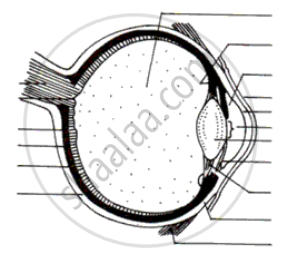
Label the following diagram :

Frank solutions for Biology [English] Class 10 ICSE 9 Nervous System Exercise 3 [Page 117]
Draw a well-labelled diagram of the vertical section of mammalian brain.
Which part of the brain is the seat of body temperature regulation?
Name the part of the brain responsible for sense of smell and mental function of intelligence and memory .
Draw a diagram of the side view of human brain and label the part which suits the following functions/ descriptions:
(i) It lies below and behind the cerebrum. It consists of three parts.
(ii) It is a cross-wise broad band of fibres which comments medulla oblongata, cerebellum and cerebrum.
(iii) It is the lower most and hinder part of the brain which continues below into spinal cord
(iv) It is a small thick-walled area which lies hidden below the cerebrum.
(v) It is the largest part of the brain which constitutes more than 80% and possesses 6-7 billion neurons.
(vi) It takes part in relaying sensory impulses and regulation of smooth muscle activity?
Frank solutions for Biology [English] Class 10 ICSE 9 Nervous System Exercise 4 [Page 118]
Where is this located?
Meninges
Where is this located?
Ganglia
Where is this located?
Cerebellum
Where is this located?
Nodes of Ranvier
Where is this located?
Effector organs
Name the respective organs in which the following are located and mention the main function of each:
(i) Iris
(ii) Semicircular canals
What is a reflex action?
Give one example of a conditioned reflex in your own life.
The diagram alongside represents the structure of the human ear.
(i) Write the names of the parts labelled a to g.
(ii) State briefly the functions of the parts b, d, and g.
(iii) Name the main division of the ear.
(iv) Which is the smallest bone in the human body?
(v) What is labyrinth?

The diagram alongside represents the structure found in the inner ear. Study the same and then answer the questions that follow:
(i) Name the parts labelled A, B, C and D.
(ii) Name the parts of the ear responsible for transmitting impulses to the brain.
(iii) Name the part labelled above which is responsible for:
1. Static equilibrium. 2. Dynamic equilibrium. 3. Hearing
(iv) Name the audio receptor cells which pick up vibrations.
(v) Name the fluid present in the inner ear.
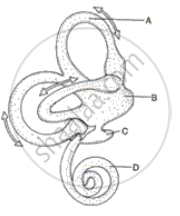
Give the main function of the following:
Cochlea
Give the main function of the following:
Fovea centralis
Give the main function of the following:
Three semicircular canals
Give the main function of the following:
Retina
Give the main function of the following:
Lachrymal glands
Give one point of difference between the following on the basis of what is indicated:
Cerebrum and spinal cord. (Arrangement of neurons)
Frank solutions for Biology [English] Class 10 ICSE 9 Nervous System Exercise 5 [Page 119]
The diagram alongside represents a certain defect of vision of the human eye.
(i) Name the defect.
(ii) Describe briefly the condition in the eye responsible for the defect.
(iii) Redraw the figure by adding a suitable lens correcting the defect. Label the parts through which light-rays pass.
(iv) What special advantage do human beings derive in having both eyes facing forward?
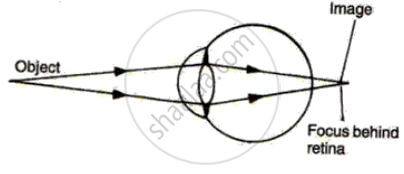
The diagram alongside represents a section of a mammalian eye.
(i) Label the parts 1 to 5 of the diagram.
(ii) State the function of the parts labelled 4 and 5.
(iii) With the help of a diagram show the short sightedness.
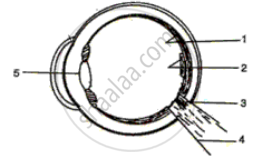
Given alongside is a diagram depicting a defect of the human eye. Study the same and then answer the questions that follow:
(i) Identify the defect.
(ii) Name the parts labelled 1, 2 and 3.
(iii) Give labelled two possible reasons for this eye defect.
(iv) Draw a labelled diagram to show how the above mentioned defect is rectified.
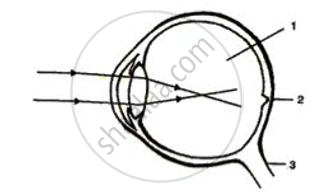
Fill in the blank with the function in the following:
Cochlea : ________
Fill in the blank with the function in the following:
Meninges: ______
Name the following:
The opening through which light enters the eyes.
Name the following:
The fluid that is present inside and outside the brain.
Write whether the following is true or false:
Axon of one neuron communicates with other nerve cell through synapse.
True
False
Write whether the following is true or false:
Neurotransmitters are released on activation.
True
False
Write whether the following is true or false:
Neurotransmitters are either broken down or reabsorbed after they have conducted an impulse.
True
False
Write whether the following is true or false:
All voluntary actions are controlled by the cerebellum.
True
False
Write whether the following is true or false:
A convex lens is used for correcting myopia.
True
False
Write whether the following is true or false:
Rods are the receptor cells in the retina of the eye sensitive to dimlight.
True
False
Write whether the following is true or false:
The part of the ear associated with balance is the cochlea.
True
False
Write whether the following is true or false:
Vitreous chamber is present in ear in humans.
True
False
Frank solutions for Biology [English] Class 10 ICSE 9 Nervous System Exercise 6 [Page 120]
Choose the correct answer.
More than one foot long cells of the body are __________
gland cell
RBC
bone cell
nerve cell
Choose the correct answer.
The largest part of the brain ____________
medulla
cerebrum
fornix
optic lobe
Choose the correct answer.
Number of spinal nerves in human beings ______________
31
10
21
12
Choose the correct answer.
Number of cranial nerves _____________
10
12
14
20
Choose the correct answer.
Outermost covering of the brain is ______.
dura mater
pia mater
arachnoid
pericardium
Choose the correct answer.
Labyrinth is a part of ____________
ear
brain
nose
eye
Choose the correct answer.
In the chemistry of vision, the photosensitive substance is _________________
melanin
sclerotin
rhodopsin
none
Choose the correct answer.
Rods are receptor of ______________
twilight vision
colour vision
sound wave
odour
Choose the correct answer.
Which one is the photoreceptor _____________
organ of corti
organ of sylvious
cristae
macula
Choose the correct answer.
Synapse is a close proximity of _______________
two veins
two arteries
two muscles
two nerves
Choose the correct answer.
Auditory nerve is responsible for ____________
smell
sight
hearing
none
Choose the correct answer.
Man has ______ pairs of spinal nerves.
30
31
32
40
Choose the correct answer.
Canal joining middle ear to pharynx ___________
eustachian
tympanic
labyrinth
none
Choose the correct answer.
Aperture controlling passage to light into the eye is ___________
blind spot
pupil
iris
cornea
Choose the correct answer.
Colour is detected by ____________
rods
cones
pigment
choroids
Choose the correct answer :
Organ of corti is found in ___________
eye
Ear
skin
none
Choose the correct answer :
The cerebral hemispheres in mammals are connected by _____________
corpus luteum
hypothalamus
pons varolli
corpus callosum
Choose the correct answer :
Presbyopia is a disease of _____________
ear
nose
mouth
eye
Choose the correct answer :
The rods and cones of a vertebrate retina function is to _________
focus light
amplify light
transduce light
filter light
Choose the correct answer :
In mammals the corpus callosum connects __________
the two optic lobes
the two cerebral hemispheres
the cerebrum to the cerebellum
the pons to the medulla oblongata
Solutions for 9: Nervous System
![Frank solutions for Biology [English] Class 10 ICSE chapter 9 - Nervous System Frank solutions for Biology [English] Class 10 ICSE chapter 9 - Nervous System - Shaalaa.com](/images/9789386811653-biology-english-class-10-icse_6:b1353f382f20442081c2a5dff2d9de4a.jpg)
Frank solutions for Biology [English] Class 10 ICSE chapter 9 - Nervous System
Shaalaa.com has the CISCE Mathematics Biology [English] Class 10 ICSE CISCE solutions in a manner that help students grasp basic concepts better and faster. The detailed, step-by-step solutions will help you understand the concepts better and clarify any confusion. Frank solutions for Mathematics Biology [English] Class 10 ICSE CISCE 9 (Nervous System) include all questions with answers and detailed explanations. This will clear students' doubts about questions and improve their application skills while preparing for board exams.
Further, we at Shaalaa.com provide such solutions so students can prepare for written exams. Frank textbook solutions can be a core help for self-study and provide excellent self-help guidance for students.
Concepts covered in Biology [English] Class 10 ICSE chapter 9 Nervous System are Major Division of the Nervous System, Neuron (Or Nerve Cell) and Its Types, Human Nervous System, Nerve Fibres, The Spinal Cord, Reflex and Reflex Action, Transmission of Nerve Impulse, Synapse - Properties of nerve fibres, The Human Brain - Forebrain, Peripheral Nervous System (PNS), Types of Reflexes, Nervous Pathways in Reflexes, Reflex Arc, Complex Reflex Action, Sense Organ, The Eyes, Human Eye, Working of the Human Eye, Eye Defect and Its Correction: Myopia Or Near-sightedness, Eye Defect and its Correction: Hypermetropia or Far-sightedness, Eye Defect and Its Correction: Presbyopia, Eye Defect and Its Correction: Astigmatism, Some Common Defects of the Eye, Stereoscopic (Binocular) Vision, Functions of the Ear, Human Ear.
Using Frank Biology [English] Class 10 ICSE solutions Nervous System exercise by students is an easy way to prepare for the exams, as they involve solutions arranged chapter-wise and also page-wise. The questions involved in Frank Solutions are essential questions that can be asked in the final exam. Maximum CISCE Biology [English] Class 10 ICSE students prefer Frank Textbook Solutions to score more in exams.
Get the free view of Chapter 9, Nervous System Biology [English] Class 10 ICSE additional questions for Mathematics Biology [English] Class 10 ICSE CISCE, and you can use Shaalaa.com to keep it handy for your exam preparation.
